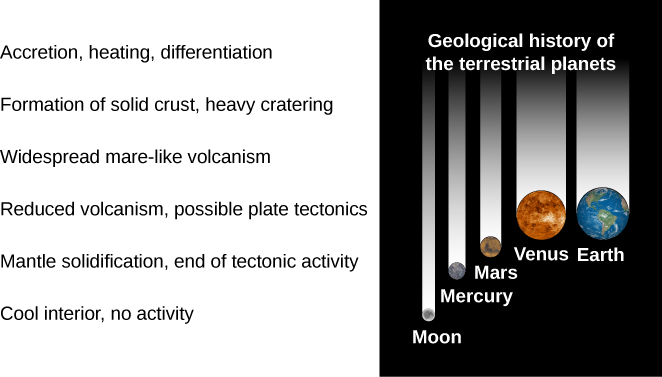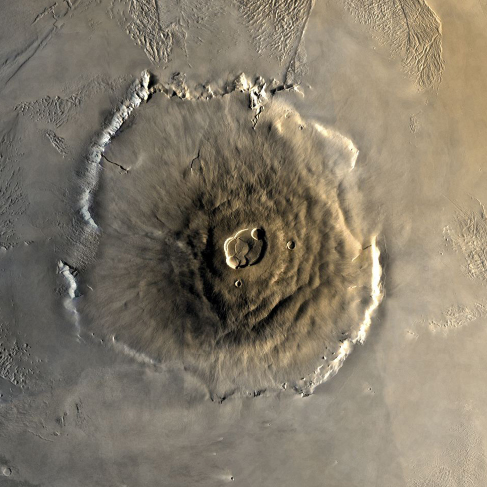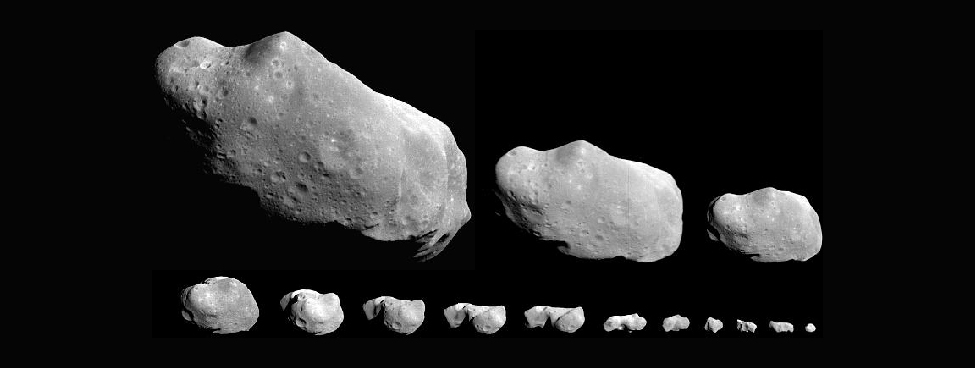Chapter 14 Cosmic Samples and the Origin of the Solar System
14.5 Planetary Evolution
Learning Objectives
By the end of this section, you will be able to:
- Describe the geological activity during the evolution of the planets, particularly on the terrestrial planets
- Describe the factors that affect differences in elevation on the terrestrial planets
- Explain how the differences in atmosphere on Venus, Earth, and Mars evolved from similar starting points in the early history of the solar system
While we await more discoveries and better understanding of other planetary systems, let us look again at the early history of our own solar system, after the dissipation of our dust disk. The era of giant impacts was probably confined to the first 100 million years of solar system history, ending by about 4.4 billion years ago. Shortly thereafter, the planets cooled and began to assume their present aspects. Up until about 4 billion years ago, they continued to acquire volatile materials, and their surfaces were heavily cratered from the remaining debris that hit them. However, as external influences declined, all the terrestrial planets as well as the moons of the outer planets began to follow their own evolutionary courses. The nature of this evolution depended on each object’s composition, mass, and distance from the Sun.
Geological Activity
We have seen a wide range in the level of geological activity on the terrestrial planets and icy moons. Internal sources of such activity (as opposed to pummeling from above) require energy, either in the form of primordial heat left over from the formation of a planet or from the decay of radioactive elements in the interior. The larger the planet or moon, the more likely it is to retain its internal heat and the more slowly it cools—this is the “baked potato effect” mentioned in Other Worlds: An Introduction to the Solar System. Therefore, we are more likely to see evidence of continuing geological activity on the surface of larger (solid) worlds ([link]). Jupiter’s moon Io is an interesting exception to this rule; we saw that it has an unusual source of heat from the gravitational flexing of its interior by the tidal pull of Jupiter. Europa is probably also heated by jovian tides. Saturn may be having a similar effect on its moon Enceladus.

The Moon, the smallest of the terrestrial worlds, was internally active until about 3.3 billion years ago, when its major volcanism ceased. Since that time, its mantle has cooled and become solid, and today even internal seismic activity has declined to almost zero. The Moon is a geologically dead world. Although we know much less about Mercury, it seems likely that this planet, too, ceased most volcanic activity about the same time the Moon did.
Mars represents an intermediate case, and it has been much more active than the Moon. The southern hemisphere crust had formed by 4 billion years ago, and the northern hemisphere volcanic plains seem to be contemporary with the lunar maria. However, the Tharsis bulge formed somewhat later, and activity in the large Tharsis volcanoes has apparently continued on and off to the present era.
Earth and Venus are the largest and most active terrestrial planets. Our planet experiences global plate tectonics driven by convection in its mantle. As a result, our surface is continually reworked, and most of Earth’s surface material is less than 200 million years old. Venus has generally similar levels of volcanic activity, but unlike Earth, it has not experienced plate tectonics. Most of its surface appears to be no more than 500 million years old. We did see that the surface of our sister planet is being modified by a kind of “blob tectonics”—where hot material from below puckers and bursts through the surface, leading to coronae, pancake volcanoes, and other such features. A better understanding of the geological differences between Venus and Earth is a high priority for planetary geologists.
The geological evolution of the icy moons and Pluto has been somewhat different from that of the terrestrial planets. Tidal energy sources have been active, and the materials nature has to work with are not the same. On these outer worlds, we see evidence of low-temperature volcanism, with the silicate lava of the inner planets being supplemented by sulfur compounds on Io, and replaced by water and other ices on Pluto and other outer-planet moons.
Elevation Differences
Let’s look at some specific examples of how planets differ. The mountains on the terrestrial planets owe their origins to different processes. On the Moon and Mercury, the major mountains are ejecta thrown up by the large basin-forming impacts that took place billions of years ago. Most large mountains on Mars are volcanoes, produced by repeated eruptions of lava from the same vents. There are similar (but smaller) volcanoes on Earth and Venus. However, the highest mountains on Earth and Venus are the result of compression and uplift of the surface. On Earth, this crustal compression results from collisions of one continental plate with another.
It is interesting to compare the maximum heights of the volcanoes on Earth, Venus, and Mars ([link]). On Venus and Earth, the maximum elevation differences between these mountains and their surroundings are about 10 kilometers. Olympus Mons, in contrast, towers more than 20 kilometers above its surroundings and nearly 30 kilometers above the lowest elevation areas on Mars.

One reason Olympus Mons ([link]) is so much higher than its terrestrial counterparts is that the crustal plates on Earth never stop moving long enough to let a really large volcano grow. Instead, the moving plate creates a long row of volcanoes like the Hawaiian Islands. On Mars (and perhaps Venus) the crust remains stationary with respect to the underlying hot spot, and so a single volcano can continue to grow for hundreds of millions of years.

A second difference relates to the strength of gravity on the three planets. The surface gravity on Venus is nearly the same as that on Earth, but on Mars it is only about one third as great. In order for a mountain to survive, its internal strength must be great enough to support its weight against the force of gravity. Volcanic rocks have known strengths, and we can calculate that on Earth, 10 kilometers is about the limit. For instance, when new lava is added to the top of Mauna Loa in Hawaii, the mountain slumps downward under its own weight. The same height limit applies on Venus, where the force of gravity is the same as Earth’s. On Mars, however, with its lesser surface gravity, much greater elevation differences can be supported, which helps explain why Olympus Mons is more than twice as high as the tallest mountains of Venus or Earth.
By the way, the same kind of calculation that determines the limiting height of a mountain can be used to ascertain the largest body that can have an irregular shape. Gravity, if it can, pulls all objects into the most “efficient” shape (where all the outside points are equally distant from the center). All the planets and larger moons are nearly spherical, due to the force of their own gravity pulling them into a sphere. But the smaller the object, the greater the departure from spherical shape that the strength of its rocks can support. For silicate bodies, the limiting diameter is about 400 kilometers; larger objects will always be approximately spherical, while smaller ones can have almost any shape (as we see in photographs of asteroids, such as [link]).

Atmospheres
The atmospheres of the planets were formed by a combination of gas escaping from their interiors and the impacts of volatile-rich debris from the outer solar system. Each of the terrestrial planets must have originally had similar atmospheres, but Mercury was too small and too hot to retain its gas. The Moon probably never had an atmosphere since the material composing it was depleted in volatile materials.
The predominant volatile gas on the terrestrial planets is now carbon dioxide (CO2), but initially there were probably also hydrogen-containing gases. In this more chemically reduced (hydrogen-dominated) environment, there should have been large amounts of carbon monoxide (CO) and traces of ammonia (NH3) and methane (CH4). Ultraviolet light from the Sun split apart the molecules of reducing gases in the inner solar system, however. Most of the light hydrogen atoms escaped, leaving behind the oxidized (oxygen-dominated) atmospheres we see today on Earth, Venus, and Mars.
The fate of water was different on each of these three planets, depending on its size and distance from the Sun. Early in its history, Mars apparently had a thick atmosphere with abundant liquid water, but it could not retain those conditions. The CO2 necessary for a substantial greenhouse effect was lost, the temperature dropped, and eventually the remaining water froze. On Venus the reverse process took place, with a runaway greenhouse effect leading to the permanent loss of water. Only Earth managed to maintain the delicate balance that permits liquid water to persist on its surface.
With the water gone, Venus and Mars each ended up with an atmosphere of about 96 percent carbon dioxide and a few percent nitrogen. On Earth, the presence first of water and then of life led to a very different kind of atmosphere. The CO2 was removed and deposited in marine sediment. The proliferation of life forms that could photosynthesize eventually led to the release of more oxygen than natural chemical reactions can remove from the atmosphere. As a result, thanks to the life on its surface, Earth finds itself with a great deficiency of CO2, with nitrogen as the most abundant gas, and the only planetary atmosphere that contains free oxygen.
In the outer solar system, Titan is the only moon with a substantial atmosphere. This object must have contained sufficient volatiles—such as ammonia, methane, and nitrogen—to form an atmosphere. Thus, today Titan’s atmosphere consists primarily of nitrogen. Compared with those on the inner planets, temperatures on Titan are too low for either carbon dioxide or water to be in vapor form. With these two common volatiles frozen solid, it is perhaps not too surprising that nitrogen has ended up as the primary atmospheric constituent.
We see that nature, starting with one set of chemical constituents, can fashion a wide range of final atmospheres appropriate to the conditions and history of each world. The atmosphere we have on Earth is the result of many eons of evolution and adaptation. And, as we saw, it can be changed by the actions of the life forms that inhabit the planet.
One of the motivations for exploration of our planetary system is the search for life, beginning with a survey for potentially habitable environments. Mercury, Venus, and the Moon are not suitable; neither are most of the moons in the outer solar system. The giant planets, which do not have solid surfaces, also fail the test for habitability.
So far, the search for habitable environments has focused on the presence of liquid water. Earth and Europa both have large oceans, although Europa’s ocean is covered with a thick crust of ice. Mars has a long history of liquid water on its surface, although the surface today is mostly dry and cold. However, there is strong evidence for subsurface water on Mars, and even today water flows briefly on the surface under the right conditions. Enceladus may have the most accessible liquid water, which is squirting into space by means of the geysers observed with our Cassini spacecraft. Titan is in many ways the most interesting world we have explored. It is far too cold for liquid water, but with its thick atmosphere and hydrocarbon lakes, it may be the best place to search for “life as we don’t know it.”
We now come to the end of our study of the planetary system. Although we have learned a great deal about the other planets during the past few decades of spacecraft exploration, much remains unknown. Discoveries in recent years of geological activity on Titan and Enceladus were unexpected, as was the complex surface of Pluto revealed by New Horizons. The study of exoplanetary systems provides a new perspective, teaching us that there is much more variety among planetary systems than scientists had imagined a few decades ago. The exploration of the solar system is one of the greatest human adventures, and, in many ways, it has just begun.
Key Concepts and Summary
After their common beginning, each of the planets evolved on its own path. Different possible outcomes are illustrated by comparison of the terrestrial planets (Earth, Venus, Mars, Mercury, and the Moon). All are rocky, differentiated objects. The level of geological activity is proportional to mass: greatest for Earth and Venus, less for Mars, and absent for the Moon and Mercury. However, tides from another nearby world can also generate heat to drive geological activity, as shown by Io, Europa, and Enceladus. Pluto is also active, to the surprise of planetary scientists. On the surfaces of solid worlds, mountains can result from impacts, volcanism, or uplift. Whatever their origin, higher mountains can be supported on smaller planets that have less surface gravity. The atmospheres of the terrestrial planets may have acquired volatile materials from comet impacts. The Moon and Mercury lost their atmospheres; most volatiles on Mars are frozen due to its greater distance from the Sun and its thinner atmosphere; and Venus retained CO2 but lost H2O when it developed a massive greenhouse effect. Only Earth still has liquid water on its surface and hence can support life.
For Further Exploration
Note: Resources about exoplanets are provided in The Birth of Stars and the Discovery of Planets outside the Solar System.
Articles
Meteors and Meteorites
Alper, J. “It Came from Outer Space.” Astronomy (November 2002): 36. On the analysis of organic materials in meteorites.
Beatty, J. “Catch a Fallen Star.” Sky & Telescope (August 2009): 22. On the recovery of meteorites from an impact that was seen in the sky.
Durda, D. “The Chelyabinsk Super-Meteor.” Sky & Telescope (June 2013): 24. A nice summary, with photos and eyewitness reporting.
Garcia, R., & Notkin, G. “Touching the Stars without Leaving Home.” Sky & Telescope (October 2008): 32. Hunting and collecting meteorites.
Kring, D. “Unlocking the Solar System’s Past.” Astronomy (August 2006): 32. Part of a special issue devoted to meteorites.
Rubin, A. “Secrets of Primitive Meteorites.” Scientific American (February 2013): 36. What they can teach us about the environment in which the solar system formed.
Evolution of the Solar System and Protoplanetary Disks
Jewitt, D., & Young, E. “Oceans from the Skies.” Scientific American (March 2015): 36–43. How did Earth and the other inner planets get their water after the initial hot period?
Talcott, R. “How the Solar System Came to Be.” Astronomy (November 2012): 24. On the formation period of the Sun and the planets.
Young, E. “Cloudy with a Chance of Stars.” Scientific American (February 2010): 34. On how clouds of interstellar matter turn into star systems.
Websites
Meteors and Meteorites
American Meteor Society: http://www.amsmeteors.org/. For serious observers.
British and Irish Meteorite Society: http://www.bimsociety.org/meteorites1.shtml.
Meteor Showers Online: http://meteorshowersonline.com/. By Gary Kronk.
Meteorite Information: http://www.meteorite-information.com/. A great collection of links for understanding and even collecting meteorites.
Meteorites from Mars: http://www2.jpl.nasa.gov/snc/. A listing and links from the Jet Propulsion Lab.
Meteors and Meteor Showers: http://www.astronomy.com/observing/observe-the-solar-system/2010/04/meteors-and-meteor-showers. From Astronomy magazine.
Meteors: http://www.skyandtelescope.com/observing/celestial-objects-to-watch/meteors/. A collection of articles on meteor observing from Sky & Telescope magazine.
Nine Planets Meteorites and Meteors Page: http://nineplanets.org/meteorites.html.
Some Interesting Meteorite Falls of the Last Two Centuries: http://www.icq.eps.harvard.edu/meteorites-1.html.
Evolution of the Solar System and Protoplanetary Disks
Circumstellar Disk Learning Site: http://www.disksite.com/. By Dr. Paul Kalas.
Disk Detective Project: http://www.diskdetective.org/. The WISE mission is asking the public to help them find protoplanetary disks in their infrared data.
Videos
Meteors and Meteorites
Meteorites and Meteor-wrongs: https://www.youtube.com/watch?v=VQO335Y3zXo. Video with Dr. Randy Korotev of Washington U. in St. Louis (7:05).
Rare Meteorites from London’s Natural History Museum: https://www.youtube.com/watch?v=w-Rsk-ywN44. A tour of the meteorite collection with curator Caroline Smith (18:22). Also see a short news piece about a martian meteorite: https://www.youtube.com/watch?v=1EMR2r53f2s (2:54).
What Is a Meteor Shower (and How to Watch Them): https://www.youtube.com/watch?v=xNmgvlwInCA. Top tips for watching meteor showers from the At-Bristol Science Center (3:18).
Evolution of the Solar System and Protoplanetary Disks
Origins of the Solar System: http://www.pbs.org/wgbh/nova/space/origins-solar-system.html. Video from Nova ScienceNow narrated by Neil deGrasse Tyson (13:02).
Where Do Planets Come From?: https://www.youtube.com/watch?v=zdIJUdZWlXo. Public talk by Anjali Tripathi in March 2016 in the Center for Astrophysics Observatory Nights Series (56:14).

